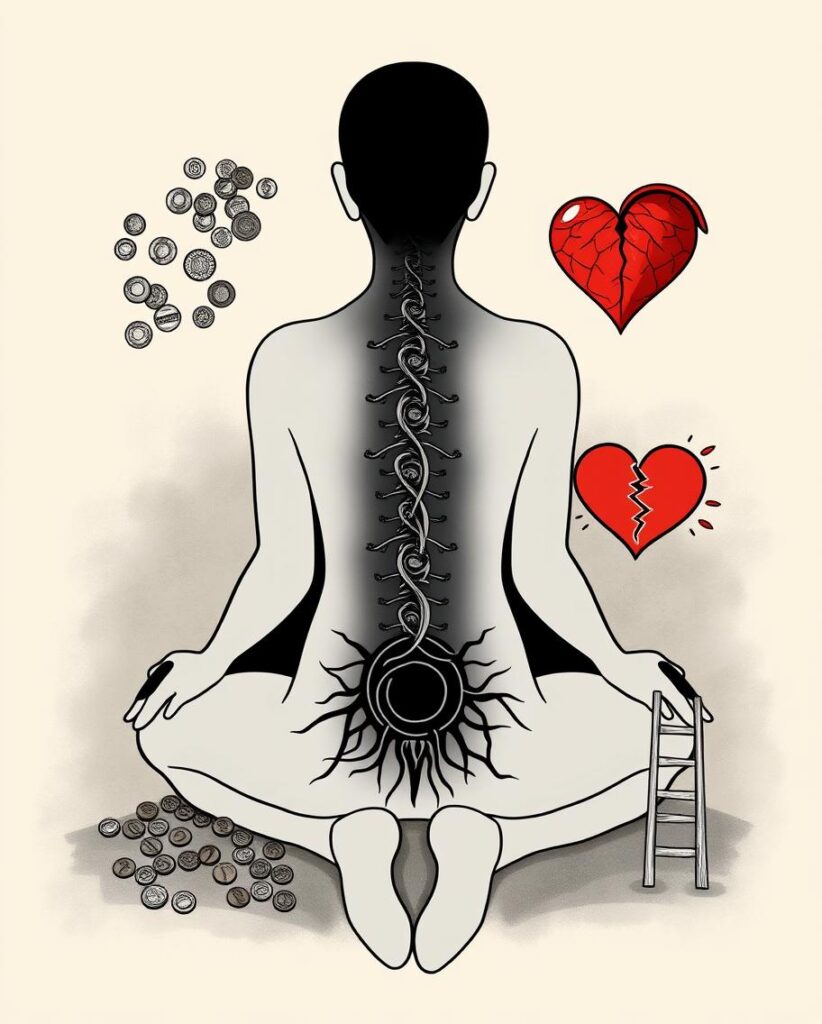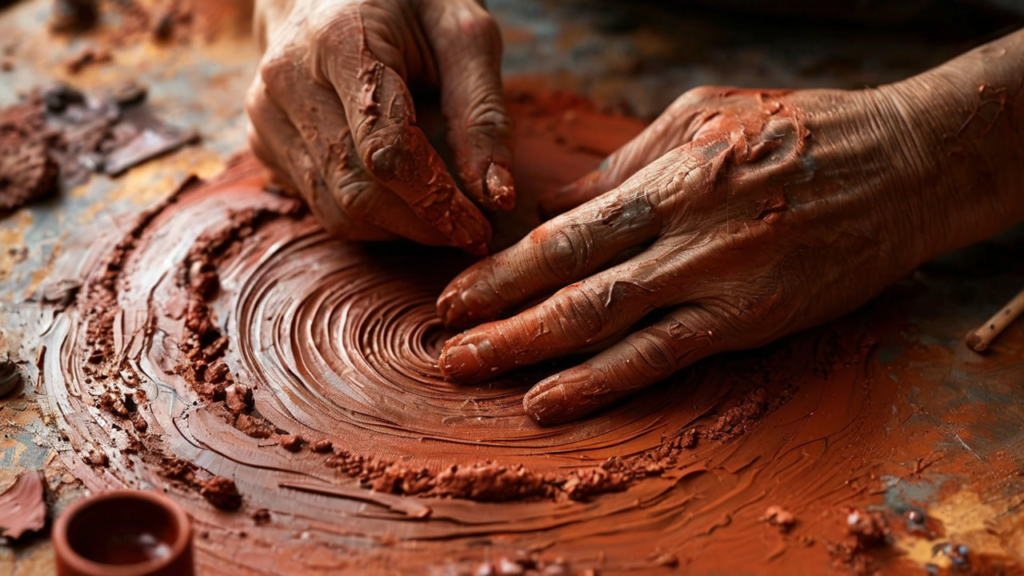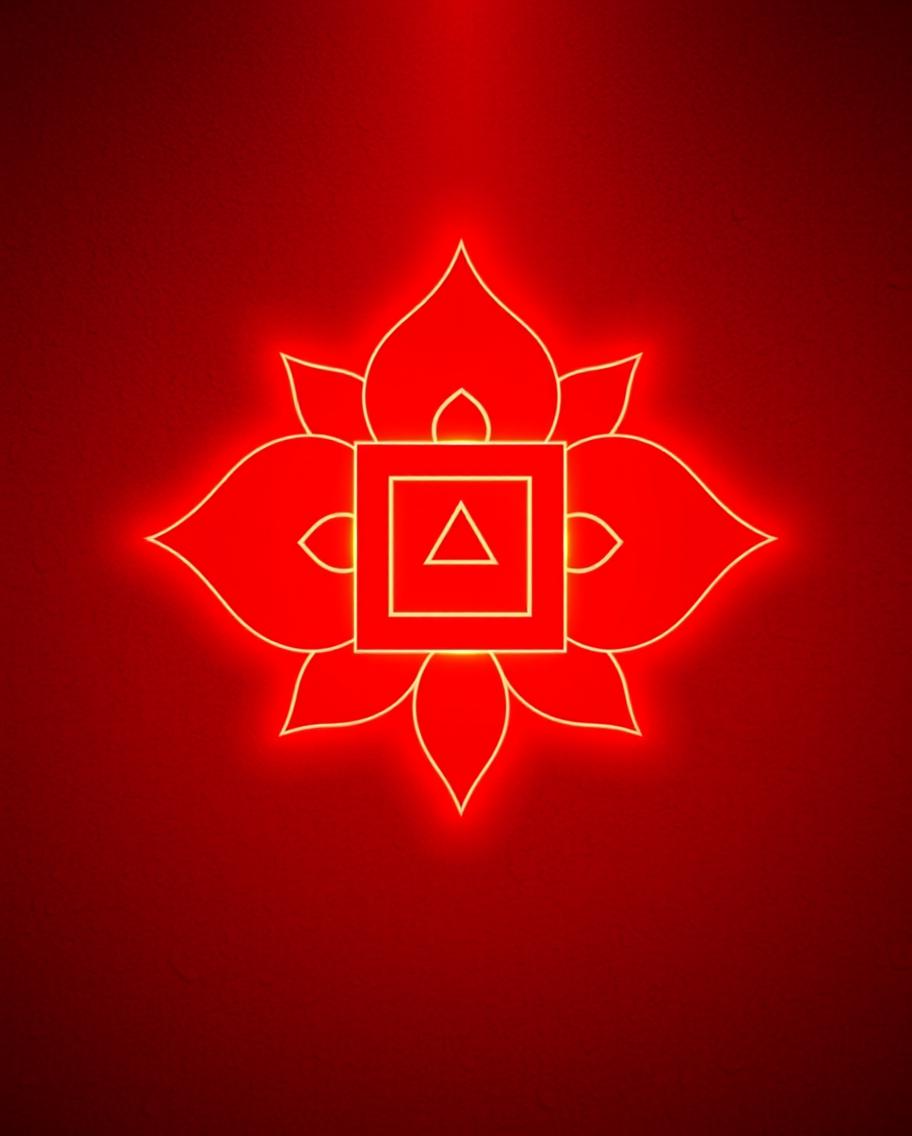The Root Chakra, known as the Mooladhara Chakra in Sanskrit, forms the foundation of our entire energy system. As the first of the seven primary chakras, it is located at the base of the spine, near the perineum, and is associated with the element Earth. The Sanskrit word “Mooladhara” translates to “root support,” signifying its essential role in grounding and stabilizing our physical and emotional well-being.
In this comprehensive guide, we’ll explore the significance of the Root Chakra, the negative effects of its imbalance on various aspects of life such as money, health, relationships, and career, and the holistic practices derived from ancient wisdom, including exercises, meditation, dance, music, and art, that can help in balancing this vital energy center.
The Root Chakra: Foundation of Life and Stability
Symbolism and Significance
The Root Chakra is often depicted as a four-petaled lotus with a square and a downward-pointing triangle, symbolizing stability and the grounding energy of the Earth. The chakra is associated with the color red, representing vitality, strength, and the life force that sustains our physical existence.
In Vedic philosophy and Upanishadic teachings, the Mooladhara Chakra is considered the seat of the dormant Kundalini energy, the divine feminine energy that, when awakened, rises through the central channel (Sushumna) and leads to spiritual enlightenment. This chakra is the foundation upon which the other chakras build, and its balance is crucial for overall well-being.
Negative Effects of an Imbalanced Root Chakra

An imbalanced Root Chakra can manifest in various ways, affecting every aspect of our lives, including financial stability, health, relationships, and career. The following are some of the common issues associated with a blocked or overactive Root Chakra
1. Financial Instability
When the Root Chakra is imbalanced, individuals may experience financial difficulties, such as an inability to save money, excessive spending, or a constant fear of financial insecurity. This chakra is deeply connected to our sense of survival, and any imbalance can lead to a scarcity mindset, where one constantly feels a lack of resources.
2. Health Issues
The Root Chakra governs the lower part of the body, including the legs, feet, intestines, and lower back. An imbalance in this chakra can lead to physical ailments such as lower back pain, sciatica, constipation, and issues related to the legs and feet. On an emotional level, it can cause feelings of anxiety, fear, and instability, leading to chronic stress and related health problems.
3. Relationship Struggles
The Root Chakra is associated with our sense of belonging and connection to the world. An imbalanced Root Chakra can lead to relationship issues, such as difficulties in forming deep connections, feelings of loneliness, and a lack of trust in others. This can manifest in clinginess, possessiveness, or, conversely, an inability to commit to relationships.
4. Career Challenges
Career stability is another area governed by the Root Chakra. When this chakra is out of balance, individuals may struggle with job security, face difficulties in finding or maintaining employment, or feel unfulfilled in their career paths. A blocked Root Chakra can create a sense of being stuck or unmotivated, hindering professional growth and success.
Balancing the Root Chakra: Techniques and Practices
Balancing the Root Chakra is essential for cultivating a strong foundation in all areas of life. Various techniques can help restore balance, drawing from ancient traditions and holistic practices. These include physical exercises, meditation, sound therapy, and creative expressions like dance, music, and art.
1. Yoga and Physical Exercises
Yoga is one of the most effective ways to balance the Root Chakra, as it combines physical movement with breath control and mindfulness. Specific asanas (postures) that focus on grounding and strengthening the lower body are particularly beneficial for the Mooladhara Chakra.
Key Asanas:
- Tadasana (Mountain Pose): This foundational pose promotes stability and grounding, helping to connect with the Earth’s energy.
- Virabhadrasana I and II (Warrior I and II): These poses strengthen the legs and promote confidence, which is essential for a balanced Root Chakra.
- Malasana (Garland Pose): This deep squat opens the hips and stimulates the lower chakras, enhancing grounding and stability.
- Vrikshasana (Tree Pose): Balancing on one leg in this pose fosters a sense of rootedness and connection to the Earth.
Regular practice of these asanas, combined with deep breathing, can help release tension from the lower body and restore balance to the Root Chakra.

2. Meditation and Pranayama
Meditation and controlled breathing (Pranayama) are powerful tools for balancing the Root Chakra. These practices help calm the mind, release fear and anxiety, and establish a deep connection with the present moment.
Root Chakra Meditation:
- Find a quiet place to sit comfortably, preferably on the floor to maintain contact with the Earth.
- Close your eyes and focus on your breath, allowing your body to relax.
- Visualize a red lotus flower at the base of your spine, glowing with vibrant energy.
- As you inhale, imagine this energy expanding and filling your entire being with warmth and stability.
- Repeat the mantra “Lam” silently or aloud, as this is the seed sound associated with the Root Chakra.
- Continue this meditation for 10-15 minutes, allowing the energy to flow freely and balance the chakra.
Pranayama:
- Nadi Shodhana (Alternate Nostril Breathing): This Pranayama technique balances the energy channels (Nadis) and helps ground the body and mind.
Deep Belly Breathing: Focus on breathing deeply into the lower abdomen, which directly stimulates the Root Chakra and promotes a sense of security

3. Sound Therapy and Music
Sound therapy is an ancient practice that uses vibrations to balance the chakras. Each chakra resonates with a specific frequency, and for the Root Chakra, this frequency is approximately 396 Hz. Listening to music or chanting mantras at this frequency can help clear blockages and restore balance.
Chants and Mantras:
- Chanting the mantra “Lam” while focusing on the Root Chakra can help activate and balance this energy center.
- Listening to or playing instruments like the drum or didgeridoo, which produce deep, resonant sounds, can also be grounding and beneficial for the Root Chakra.
Music:
- Listening to grounding music with deep bass tones and earthy rhythms can help stabilize the Root Chakra. Genres like traditional drumming, certain types of classical music, and nature sounds (like the sound of footsteps on the ground or the rustling of leaves) are particularly effective.
4. Dance and Movement
Dance is a form of expression that allows for the free flow of energy throughout the body. Engaging in dance, particularly movements that involve the hips, legs, and feet, can help release stagnant energy from the Root Chakra and promote grounding.
Grounding Dance Practices:
- Ecstatic Dance: This form of free-form dance allows individuals to move intuitively, releasing any tension in the lower body and connecting with the Earth’s energy.
- Traditional Tribal Dance: Many indigenous cultures have dances that are specifically designed to connect with the Earth and promote grounding. These dances often involve rhythmic stomping and movements that align with the heartbeat of the Earth.


5. Art and Creative Expression
Creative expression through art can be a therapeutic way to balance the Root Chakra. Engaging in activities that involve the hands and feet, such as pottery, sculpting, or painting with earthy colors, can help ground the energy and bring balance to the Mooladhara Chakra.
Artistic Practices:
- Mandala Creation: Drawing or coloring mandalas, especially those with symmetrical patterns and earthy tones, can be a meditative practice that grounds the Root Chakra.
- Clay Sculpting: Working with clay, a material directly derived from the Earth, allows for a tactile connection with the root energy, promoting stability and balance.
Ancient Wisdom on the Root Chakra
The importance of the Root Chakra is echoed in various ancient scriptures and teachings, where it is regarded as the foundation of spiritual practice and material well-being.
1. Vedic References
The Vedas, the oldest sacred texts of Hinduism, emphasize the importance of grounding and stability as essential qualities for spiritual growth. The Root Chakra’s connection to the Earth element is highlighted in rituals and practices that involve offerings to the Earth and the establishment of a sacred space for spiritual practices.
2. Upanishadic Teachings
The Upanishads, which explore the deeper philosophical aspects of the Vedas, discuss the concept of Kundalini energy and its awakening through the chakras. The Mooladhara Chakra is considered the starting point of this spiritual journey, where the Kundalini energy lies dormant. The awakening and balancing of the Root Chakra are seen as crucial steps in achieving higher states of consciousness and self-realization.
3. Lalitha Sahasranama The Lalitha Sahasranama, a text dedicated to the Goddess Lalitha, describes her as the embodiment of the Kundalini energy. One of her names is “Mooladharaika Nilaya,” meaning “She who resides in the Mooladhara Chakra.” This highlights the significance of the Root Chakra as the seat of divine energy and the importance of its balance in spiritual practice
Conclusion
The Root Chakra, or Mooladhara Chakra, is the cornerstone of our physical, emotional, and spiritual well-being. Its balance is essential for a stable and secure life, influencing everything from financial stability and health to relationships and career success. By incorporating practices such as yoga, meditation, sound therapy.
Although, it appears to be simple, readers are advised to seek the guidance of a trained Guru in Chakras

